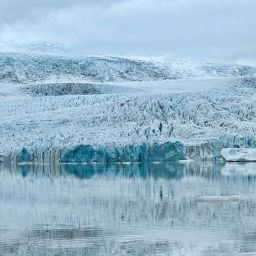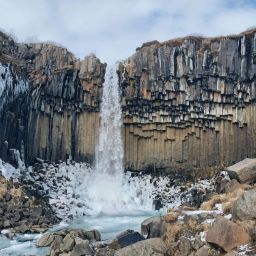
If you’ve been planning an ice cave tour, then it’s likely that you’ve been looking at pictures of these dazzling landforms online. If you have, one thing that will have struck you is how blue the ice often is. This might seem odd – after all, glacier ice starts as compacted snow and snow’s white, right? In this article, we’ll look at the science behind Vatnajökull’s blue ice and see what happens to make it so.
What happens in the glacier’s zone of accumulation?
Let’s start by looking at the glacier itself. Geographers describe these landforms as having different zones which helps when explaining the processes that occur in this dynamic and constantly changing environment. For instance, at the bottom of the glacier, the lower elevations mean that this is where temperatures are highest and therefore where the ice is most likely to be able to melt. We call this the zone of ablation.
Conversely, snow falls at the top of the glacier. Up here, the temperatures are much colder and the moisture in the air falls as frozen flakes. These build up as they fall, just as they would if it was snowing in your own backyard. We refer to this as the zone of accumulation. Over time, new snow falls on top of old snow, compressing what’s underneath. This snow is crystalline or granular and we call it firn.

The effect of light on snow, firn and newly formed ice
Sunlight comprises many different colours. Light travels as a wave and you can measure its wavelength by working out the distance from the top of two adjacent waves. Each wavelength can be seen as a band of colour. We see this when a rainbow forms because the water droplets catch the light and act like prisms, splitting the light into its different colours.
When light hits snow, it reflects off ice crystals and off the air between the flakes. As light hits an ice crystal, it bounces it away. As it does so it collides with another ice crystal which sends it in a different direction. Eventually, in this way, the light is scattered in many directions. When you see all this reflected light together, it appears white, which is why we see snow as white even though it’s actually translucent.
Compressing snow into ice changes things
Over time, snow builds up and the older ice is buried under layers of new snow. Under their weight, the snow is pressed down and compacts into ice. At this point, it still has plenty of air trapped in it, which is why if you look at ice that is relatively new, it too appears white to our eyes.
But the more snow that falls, the more the ice is compressed and the denser it becomes. The air bubbles are squeezed and become smaller. It absorbs more light. But it still scatters the blue light which has the shortest wavelength – if we go back to the rainbow, the smallest arches of colour in the centre of the rainbow are blues and violets.
How does light reach the ice that’s buried deep beneath other layers?
From the surface, we might see blue ice within a crevasse, but the most impressive sight of blue ice is within an ice cave, such as those you find under Vatnajökull glacier. Light needs to be able to get through the newer ice and snow on the surface of the glacier for the ice that forms the ice cave to appear blue.

In summer, temperatures rise on the surface of the glacier and melting occurs. Under the influence of gravity, this meltwater works its way downwards. It finds cracks and weaknesses on the glacier’s surface and takes advantage of them. As it does so, it forms a vertical shaft called a moulin or glacier mill which provides a route for further meltwater to widen the hole. This gap allows more light to access the lower layers of the ice and as the ice scatters this light, it looks blue.
A magical underground world
A vast ice sheet such as Vatnajökull will contain many of these moulins, but also larger underground caverns hollowed out of the ice by the meltwater. Surrounded by blue ice, visitors to these blue ice caves are transfixed by their beauty, which takes on an almost ethereal quality.
As the meltwater carves out a space within the ice, the trickling liquid creates a dimpled effect on the walls of ice. It’s this, coupled with their translucence, which places the suggestion of a gemstone in people’s minds. These are the crystal caves that hold such a fascination to tourists – and in reality, they don’t disappoint.

Visit an ice cave with Fjallsárlón Iceberg Boat Tour
If you’re keen to see one of these incredible natural landforms for yourself, you’ll be pleased to know that Fjallsárlón operates seasonal ice cave tours. They take place when conditions allow, between November and March. This is when the ice is more stable because of the prolonged cold temperatures. As it gets´s colder, the caves get better therefore we do not offer ice caves during early autumn as the caves are then not in condition. At Fjallsárlón we also aim to go when the caves are less busy for a more intimate and private experience.
On our guided tours, we immerse ourselves in the Icelandic wilderness as we make our way in an 4×4 vehicle to reach an ice cave within Breiðamerkurjökull, an outlet glacier of Vatnajökull. In small groups capped at twelve guests, our guides lead adventurous travellers into this magical environment.
A guide is essential. Unlike a regular hike, this is not an activity that is safe to do on your own. Our guides are highly trained and understand the challenges of dynamic glacial landscapes. You should never underestimate the power of nature, but we monitor the ice caves we visit carefully and only set out if we believe it’s safe to do so.
We have amazing 5 out of 5 stars reviews on Google for our glacier tours. Choosing the right tour operator can be difficult as there are so many companies offering ice cave tours in the in the area. We have the best check in facilities in the area, offer free refreshments, free parking so if you are looking for a personal tour, with experienced guides you should check out our tour!
Who can take an ice cave tour with us and how should you prepare?
This tour is accessible for children aged 8 and over. Most visitors who are in reasonable shape will find it easy, with no climbing involved. You’ll need to wear hiking boots with ankle support and a decent tread, just as you would for a regular hike in the Icelandic countryside. We’ll provide you with microspikes that pull on over the soles of your own boots to give you added grip for places where the ice makes it slippery. Boots can be rented on location.

Warm clothing is also a must, as the closer you get to the ice, the more you’ll feel the chill. Dress in layers that have thermal properties but also the capability to wick away moisture as this will keep you the most comfortable. Don’t forget a hat – make sure it will fit under the helmet we give you – and gloves. Rain jacket and rain pants can be rented on location.
It gets cold in winter but trust us an ice cave tour is totally worth it! We’ll help you warm up afterwards by offering you delicious tomato soup at Frost restaurant back at Fjallsárlón Glacier Lagoon. There, you can enjoy the view of the glacier from a different angle and compare notes with your fellow guests, sure to be like-minded explorers. We’re easy to find, close to the ring road, and there’s plenty of car parking, parking is also free of charge at Fjallsarlon.
Stepping inside an ice cave is a once in a lifetime experience and one you’ll be delighted to cross off your bucket list. Why not take a look at our website and lock in your ice cave adventure today?
















